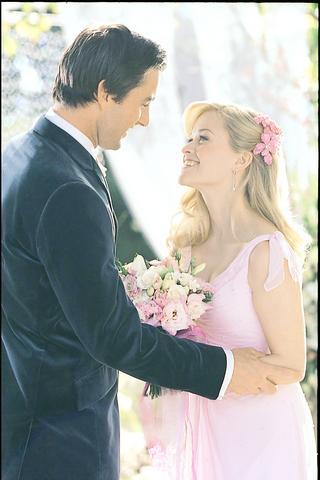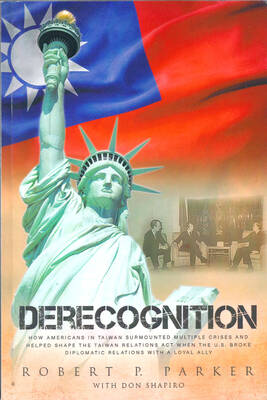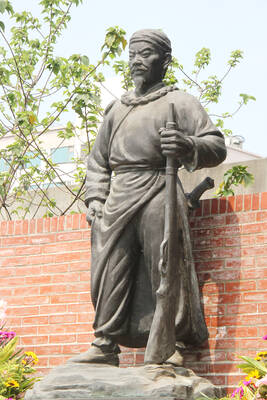Legally Blonde 2: Red White and Blonde, the sequel to 2001's Legally Blonde, is a movie for people who somehow managed to miss the point of the first picture, itself the kind of material that put the "b" in subtle, as the old joke goes. And old jokes are really what Blonde 2 is all about. Reese Witherspoon returns as Elle Woods, the indefatigable sprig of a girl whose disposition is as sunshiny as her hair. Previously she conquered Harvard Law School, a place in need of a new world order, and in the nominal sequel she takes on the moribund legislative branch.
Elle is working as an aide to Representative Rudd (Sally Field), a fellow Delta Nu. Probably the funniest thing in the picture is seeing these Oscar-size forces of nature: Witherspoon, the most determined actress of the 21st century, is posed, pert nose to nose, with Field, whose blurted "You really like me" sentiment disguised a will equally as steely. But the director, Charles Herman-Wurmfeld, and the writer, Kate Kondell, don't make enough of this matchup.
Instead Blonde 2 is repetitive, going over the same material as the first film. The snappy, happy Elle is ridiculed by Rudd's worldly and world-weary aides, especially the tough, crude Grace (Regina King). So she has to wear them down, win them over yet still find time to get an anti-animal-cruelty bill passed and marry her fiance, Emmett (Luke Wilson, who's spending so much time standing behind do-it-themselves superwomen this summer that he seems to be auditioning for the part of Steve Trevor in a future version of Wonder Woman).

PHOTO COURTESY OF FOX
There are a few good jokes about tolerance toward gays: Elle's doggie Bruiser Woods (Moondoggie) comes out of the doghouse, so to speak. Moondoggie is as expressive this time around as he was in the predecessor and gets his laughs. The movie assumes not only that Elle did not learn anything from the first movie, but that its lessons of perseverance and open-mindedness were lost on the audience, too; that we're apparently suffering the same short-term memory loss that afflicted Guy Pearce in Memento.
After suffering the insults of Rudd's staff, not to mention running into a few walls trying to use the old-fashioned methods of getting a bill passed, Elle coos, "I'm gonna do it the Elle Woods way." This means convening her posse, allowing room for the return of Jennifer Coolidge at her ditziest and rooting around for advantages and inside tracks that are a lot more similar to old-school lobbying than this movie would have us believe. Eventually Elle has to remind those whom she presumed to be on her side of their (blond) roots.
This state of willfulness makes Elle look less than bright, rather than merely shallow, a distinction that was made rather neatly the first time around as well as the neat goof that blondes were a maligned minority. The sequel makes the mild variations on a theme so obvious that this is as much a movie for kids as anything else, despite the hoochy-rific dance number in the Senate that's meant to galvanize Congress into supporting Elle's anti-cruelty amendment, which she calls Bruiser's bill.
Elle is still a bonbon wrapped in pink, but she goes so far into demented variations on that pastel that she seems to be part of a renegade faction of the Mary Kay organization. The costume designer Sophie de Rakoff Carbonell gives Elle one great ensemble -- a bubble-yum-hued suit and pillbox hat that could've been lifted from a Jackie Kennedy photo spread in Look magazine. But this time Elle is crassly stylized instead of stylish; the Elle Woods of the first film would've taken her aside to provide a few sisterly fashion tips.

One of the biggest sore spots in Taiwan’s historical friendship with the US came in 1979 when US president Jimmy Carter broke off formal diplomatic relations with Taiwan’s Republic of China (ROC) government so that the US could establish relations with the People’s Republic of China (PRC). Taiwan’s derecognition came purely at China’s insistence, and the US took the deal. Retired American diplomat John Tkacik, who for almost decade surrounding that schism, from 1974 to 1982, worked in embassies in Taipei and Beijing and at the Taiwan Desk in Washington DC, recently argued in the Taipei Times that “President Carter’s derecognition

This year will go down in the history books. Taiwan faces enormous turmoil and uncertainty in the coming months. Which political parties are in a good position to handle big changes? All of the main parties are beset with challenges. Taking stock, this column examined the Taiwan People’s Party (TPP) (“Huang Kuo-chang’s choking the life out of the TPP,” May 28, page 12), the Democratic Progressive Party (DPP) (“Challenges amid choppy waters for the DPP,” June 14, page 12) and the Chinese Nationalist Party (KMT) (“KMT struggles to seize opportunities as ‘interesting times’ loom,” June 20, page 11). Times like these can

JUNE 30 to JULY 6 After being routed by the Japanese in the bloody battle of Baguashan (八卦山), Hsu Hsiang (徐驤) and a handful of surviving Hakka fighters sped toward Tainan. There, he would meet with Liu Yung-fu (劉永福), leader of the Black Flag Army who had assumed control of the resisting Republic of Formosa after its president and vice-president fled to China. Hsu, who had been fighting non-stop for over two months from Taoyuan to Changhua, was reportedly injured and exhausted. As the story goes, Liu advised that Hsu take shelter in China to recover and regroup, but Hsu steadfastly

You can tell a lot about a generation from the contents of their cool box: nowadays the barbecue ice bucket is likely to be filled with hard seltzers, non-alcoholic beers and fluorescent BuzzBallz — a particular favorite among Gen Z. Two decades ago, it was WKD, Bacardi Breezers and the odd Smirnoff Ice bobbing in a puddle of melted ice. And while nostalgia may have brought back some alcopops, the new wave of ready-to-drink (RTD) options look and taste noticeably different. It is not just the drinks that have changed, but drinking habits too, driven in part by more health-conscious consumers and